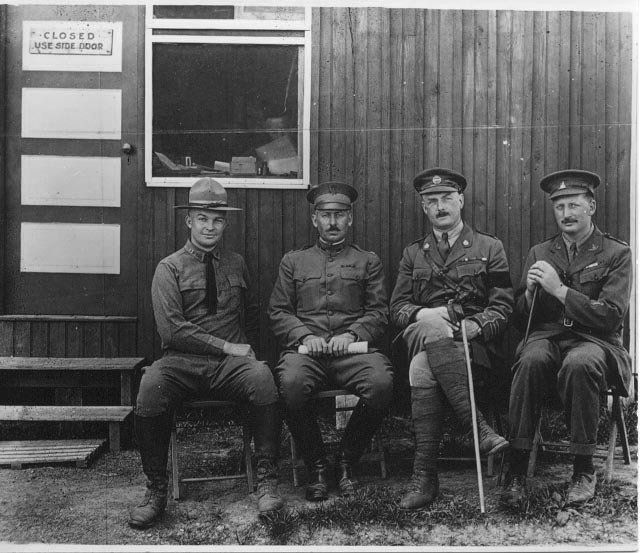Two Comrades
by Diana Loski
Camp Colt 1918
Ike (left) at Camp Colt, 1918
(Eisenhower National Historic Site)
When General and Mrs. Eisenhower returned to Gettysburg in 1961, after his two terms as President, they often attended the Gettysburg Presbyterian Church on Baltimore Street whenever they were in town.
A longtime member of that church one Sunday happened to serve as an usher on one particular Sunday, when the Eisenhowers attended. He was Arthur William Warman.
Art Warman and Ike had a common experience between them. In 1918, during World War I, Lieutenant Dwight D. Eisenhower was the commander of Camp Colt. The camp, which only lasted for nine months, trained recruits in familiarizing themselves with tank warfare. Today, on the battlefield, are two armories seen, one on Seminary Ridge and one on the Taneytown Road. The wide brick edifices were used to store the tanks – the war’s newest weapon. Because Gettysburg shared a similar landscape with the Ardennes region of France, and since the battlefield’s preservation offered endless acreage for training, the camp was quickly utilized.
Ike was 27 years old when he commanded the camp. He was a husband and father. No doubt he seemed ancient to the young soldiers under his care.
Art Warman, born in 1899 in the village of Galien, Michigan, was nineteen years old when he came to Gettysburg to train at Camp Colt. The youngest child and only son of Delbert and Effie Warman, Art enlisted shortly after his mother’s death in 1917. His father had died in 1913. While still in his teens, Art nevertheless was already tall, and slender. He quickly took to his new surroundings. He often found himself in the vicinity of his commander.
The camp ended and was quickly erased in December 1918, just weeks after the war ended on Armistice Day. Most of the young men dispersed. Art, however, stayed in Gettysburg. Without his parents, and with his older sisters married and settled, he decided not to return to Michigan. Another, more important reason, was a local girl he had met during his time at Camp Colt. She was Lila Myers.
The couple married soon after the camp was disbanded. They lived on Middle Street and raised four children: Arthur, Jr., born in 1919, Thelma, born in 1921, Clayton, born in 1924, and Ruth, born in 1927. Lila died in 1935.
Arthur worked as the assistant postmaster for the town of Gettysburg for many years, until his retirement. He also registered for the draft during World War II, when he was 43 years old. As a veteran of World War I, he was a member of the Albert Lentz Post #202 of the American Legion.
He was a faithful member of the Gettysburg Presbyterian Church, where he often served as an usher.
Fate brought Art face-to-face with his old commander one Sunday morning. As he led the Eisenhowers to their seats, Art said, “General, I don’t think you remember me, but I served with you in Camp Colt.”
Ike looked squarely at the usher, and for a moment Art didn’t know if he would speak at all to him. But the Supreme Allied Commander did reply.
“That was a hell of a long time ago, wasn’t it?” the general said.
Art agreed that it was.
The former President died on March 28, 1969 of heart disease. Art lived to age 92. He died at Gettysburg Hospital on February 7, 1991, just two weeks after his birthday. He is buried in Evergreen Cemetery.
Gettysburg has long been a place of reunion for many veterans. In a local church one Sunday, two comrades from World War I came briefly together again, evoking a memory of long ago.
Many thanks to Bill Little, a regular reader of our magazine and friend of Art Warman, who shared the tale of these two veterans. Additional information was found on the obituary of Arthur W. Warman, Sr., The Gettysburg Times, February 9, 1991, the Warman Family Tree at Ancestry.com, and Arthur Warman’s military records, National Archives, at NARA.gov.



